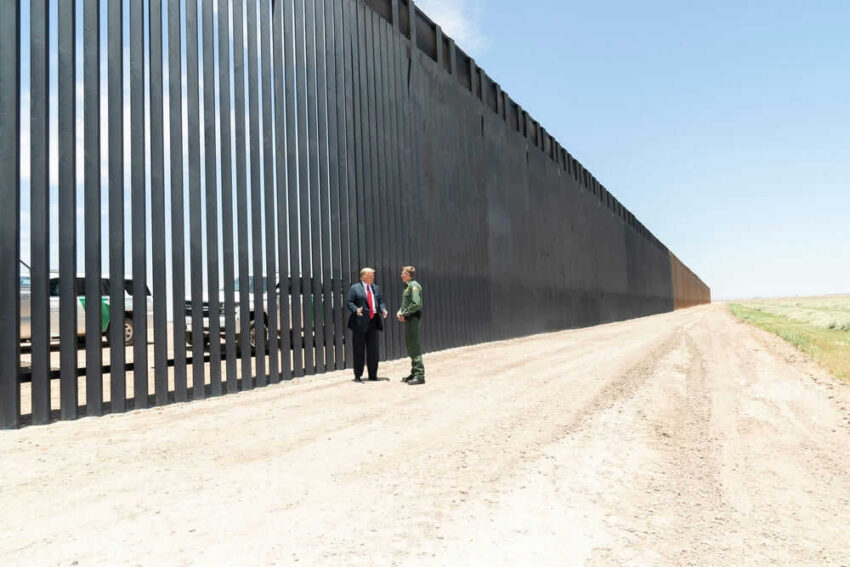(LibertySociety.com) – President Trump’s bold directive to paint the southern border wall black signals a renewed, aggressive stand against illegal immigration, and critics say it’s a move sure to ignite fierce debate over cost, effectiveness, and national priorities.
Story Snapshot
- The Department of Homeland Security, led by Secretary Kristi Noem, will paint the U.S.-Mexico border wall black to deter illegal crossings by making the barrier hotter and harder to climb.
- This initiative fulfills Trump’s long-standing promise from his first term and is funded by the “One Big Beautiful Bill Act.”
- New surveillance technology and border security upgrades are being implemented alongside the paint project.
- Experts and advocates disagree on the deterrent’s effectiveness and warn of increased risks and costs.
Trump’s Black Border Wall: A New Phase in Physical Deterrence
On August 19, 2025, Secretary of Homeland Security Kristi Noem, under President Donald Trump’s direct orders, announced that the entire U.S.-Mexico border wall will be painted black. The administration claims the dark paint will dramatically increase the wall’s surface temperature, especially under the punishing sun of the southern border, making it more difficult and dangerous to climb. This measure, part of a broader border security overhaul, is being rolled out alongside new surveillance technology and other physical upgrades. The project marks a striking return to Trump’s signature tough-on-immigration strategy, delivering on campaign promises left unfinished during his first term.
The decision to paint the wall black is not new, Trump first expressed this desire in 2019, with limited tests in 2020. However, the comprehensive implementation was delayed until now due to political and funding constraints. With the passage of the “One Big Beautiful Bill Act” in August 2025, the administration secured funding for the plan. According to DHS, the project is already underway, with work crews set to cover the wall at a pace of nearly half a mile per day. DHS officials, citing procurement sensitivity, have declined to release precise cost estimates but emphasize that the effort is part of a larger, multi-pronged approach to border security.
Stakeholders, Motivations, and the Push for Border Security
President Trump and Secretary Noem are the central decision-makers behind this move, motivated by a desire to deter illegal crossings and fulfill campaign promises to supporters who feel border security was neglected under previous administrations. The Department of Homeland Security is responsible for execution, while Congress provided the necessary funding. Local border communities and advocacy groups, however, have limited direct influence but may shape the project’s public perception. Trump’s base, frustrated by what they view as years of governmental inaction and “woke” policies, sees the black wall as a tangible symbol of renewed resolve to restore law and order and defend American sovereignty.
Border security policy has always been a flashpoint in American politics, but the black paint initiative stands out for using environmental factors as a deterrent. The hope is that the scorching surface will physically discourage would-be crossers, supplementing other barriers such as anti-climb plates and concertina wire. Yet, the measure is not without controversy. Critics, including some engineers and human rights groups, question its effectiveness and warn of humanitarian risks, particularly the potential for severe burns or heat-related injuries among migrants. Supporters counter that the deterrent effect justifies the expense and that physical and technological upgrades are necessary to safeguard the border.
Effectiveness, Risks, and the Broader Policy Context
Expert opinions on the black paint strategy are mixed. Security analysts note that while increasing the wall’s temperature may deter some crossings during the day, its impact is likely to be less significant at night or in cooler months. Academic studies suggest that determined individuals often find ways to circumvent physical barriers, regardless of design tweaks. Nevertheless, the Trump administration is banking on a show of strength and technological integration, new surveillance systems, rapid response teams, and expanded law enforcement cooperation, to reduce illegal crossings. Early reports indicate a noticeable drop in attempted crossings since the administration’s return and the start of new enforcement measures.
The long-term outlook remains uncertain. While the administration touts the project as a cost-effective way to reinforce border security and uphold the rule of law, questions persist about ongoing maintenance, potential legal challenges, and the humanitarian impact. Critics argue that such dramatic visual changes may be more symbolic than substantive, while supporters hail the project as a necessary step in restoring order and protecting American communities. Ultimately, the black wall has become a powerful emblem in the ongoing battle over border security, sovereignty, and the future of American immigration policy.
Copyright 2025, LibertySociety.com .
Click this link for the original source of this article.
Author: Editor
This content is courtesy of, and owned and copyrighted by, https://libertysociety.com and its author. This content is made available by use of the public RSS feed offered by the host site and is used for educational purposes only. If you are the author or represent the host site and would like this content removed now and in the future, please contact USSANews.com using the email address in the Contact page found in the website menu.





